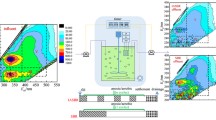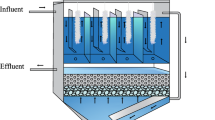Abstract
A traditional sequencing batch reactor (SBR) and two intermittently aerated sequencing batch reactors (IASBRs) were parallelly operated for treating digested piggery wastewater. Their microbial communities were analyzed, and the nitrogen removal performance was compared during the long–term run. IASBRs demonstrated higher removal rates of total nitrogen (TN) and ammonium nitrogen (NH4 +-N) than the SBR, and also demonstrated higher resistance against TN shock load. It was found that the more switch times between aerobic/anoxic in an IASBR, the higher the removal rates of TN and NH4 +–N. All the reactors were predominated by Thauera, Nitrosomonas and Nitrobacter, which were considered to be species of denitrifiers, ammonium oxidizing bacteria (AOB) and nitrite oxidizing bacteria (NOB), respectively. However, the abundance and diversity was of great difference. Compared with SBR, IASBRs achieved higher abundance of denitrification–related bacteria. IASBR 1# with four aerobic/anoxic switch times was detected with 25.63% of Thauera, higher than that in IASBR 2# with two aerobic/anoxic switch times (11.57% of Thauera), and much higher than that in the SBR (only 6.19%of Thauera). IASBR 2# had the highest percentage of AOB, while IASBR 1# had the lowest percentage. The denitrifiers abundance was significantly positive correlated with the TN removal rate. However, the NH4 +–N removal rate showed no significant correlation with the AOB abundance, but might relate to the AOB activity which was influenced by the average free ammonium (FA) concentration. Nitrobacter was the only NOB genus detectable in all reactors, and were less than 0.03%.

Similar content being viewed by others
References
Wang L K, Zeng G M, Yang Z H, Luo L L, Xu H Y, Huang J. Operation of partial nitrification to nitrite of landfill leachate and its performance with respect to different oxygen conditions. Biochemical Engineering Journal, 2014, 87: 62–68
Okabe S, Oshiki M, Takahashi Y, Satoh H. Development of long–term stable partial nitrification and subsequent anammox process. Bioresource Technology, 2011, 102(13): 6801–6807
Katsogiannis A, Kornaros M, Lyberatos G. Enhanced nitrogen removal in SBRs bypassing nitrate generation accomplished by multiple aerobic/anoxic phase pairs. Water Science and Technology, 2003, 47(11): 53–59
Li J, Elliott D, Nielsen M, Healy M G, Zhan X. Long–term partial nitrification in an intermittently aerated sequencing batch reactor (SBR) treating ammonium–rich wastewater under controlled oxygen–limited conditions. Biochemical Engineering Journal, 2011, 55(3): 215–222
Li J, Meng J, Li J, Wang C, Deng K, Sun K, Buelna G. The effect and biological mechanism of COD/TN ratio on nitrogen removal in a novel upflow microaerobic sludge reactor treating manure–free piggery wastewater. Bioresource Technology, 2016, 209: 360–368
Sotres A, Cerrillo M, Viñas M, Bonmatí A. Nitrogen removal in a two–chambered microbial fuel cell: establishment of a nitrifying–denitrifying microbial community on an intermittent aerated cathode. Chemical Engineering Journal, 2016, 284: 905–916
MEPPRC (Ministry Environmental Protection of People’s Republic of China). Standard Methods for Water and Wastewater Monitoring and Analysis. 4th ed. Beijing: China Environmental Science Press, 2002, 238–239; 252–256; 260–263; 266–269; 345–356
Zhang J, Lv C, Tong J, Tong J, Wei Y. Optimization and microbial community analysis of anaerobic co-digestion of food waste and sewage sludge based on microwave pretreatment. Bioresource Technology, 2016, 200(2): 253–261
Kornaros M S N D, Lyberatos G. Partial nitrification/denitrification can be attributed to the slow response of nitrite oxidizing bacteria to periodic anoxic disturbances. Environmental Science and Technology, 2010, 44(19): 7245–7253
Alzate M J C, Caravelli A H, Zaritzky N E. Nitrification and aerobic denitrification in anoxic–aerobic sequencing batch reactor. Bioresource Technology, 2016, 200: 380–387
Zhang G, Jiao Y, Lee D J. Leachate treatment using anoxic/oxic–bioelectrochemical reactor with intermittent aeration. Journal of the Taiwan Institute of Chemical Engineers, 2015, 58: 401–406
Chen A C, Chang J S, Yang L, Yang Y H. Nitrogen removal from sewage by continuous flow SBR system with intermittent aeration. Environmental Technology, 2001, 22(5): 553–559
Li J, Healy M G, Zhan X, Nortan D, Rodgers M. Effect of aeration rate on nutrient removal from slaughterhouse wastewater in intermittently aerated sequencing batch reactors. Water, Air, and Soil Pollution, 2008, 192(1–4): 251–261
Li H, Zhou S, Huang G, Xu B. Partial nitritation of landfill leachate with varying influent composition under intermittent aeration conditions. Process Safety and Environmental Protection, 2013, 91(4): 285–294
Zhang M, Lawlor P G, Wu G, Lynch B, Zhan X. Partial nitrification and nutrient removal in intermittently-aerated sequencing batch reactors treating separated digestate liquid after anaerobic digestion of pig manure. Bioprocess and Biosystems Engineering, 2011, 34 (9): 1049–1056
Anthonisen A C, Loehr R C, Prakasam T B S, Srinath E G. Inhibition of nitrification by ammonia and nitrous acid. Journal- Water Pollution Control Federation, 1976, 48(5): 835–852
Bae W, Baek S, Chung J, Lee Y. Optimal operational factors for nitrite accumulation in batch reactors. Biodegradation, 2001, 12(5): 359–366
Yang S F, Tay J H, Liu Y. Inhibition of free ammonia to the formation of aerobic granules. Biochemical Engineering Journal, 2004, 17(1): 41–48
Jia S, Han H, Zhuang H, Hou B, Li K. Impact of high external circulation ratio on the performance of anaerobic reactor treating coal gasification wastewater under thermophilic condition. Bioresource Technology, 2015, 192: 507–513
Yang S, Yang F, Fu Z, Wang T, Lei R. Simultaneous nitrogen and phosphorus removal by a novel sequencing batch moving bed membrane bioreactor for wastewater treatment. Journal of Hazardous Materials, 2010, 175(1–3): 551–557
Peng Y, Zhu G. Biological nitrogen removal with nitrification and denitrification via nitrite pathway. Applied Microbiology and Biotechnology, 2006, 73(1): 15–26
Yi J, Dong B, Jin J, Dai X. Effect of increasing total solids contents on anaerobic digestion of food waste under mesophilic conditions: performance and microbial characteristics analysis. PLoS One, 2014, 9(7): e102548
Spring S, Jackel U, Wagner M, Kampfer P. Ottowia thiooxydans gen. nov., sp. nov., a novel facultatively anaerobic, N2O–producing bacterium isolated from activated sludge, and transfer of Aquaspirillum gracile to Hylemonella gracilis gen. nov., comb. nov. International Journal of Systematic and Evolutionary Microbiology, 2004, 54(Pt 1): 99–106
Yang Q, Xiong P, Ding P, Chu L, Wang J. Treatment of petrochemical wastewater by microaerobic hydrolysis and anoxic/oxic processes and analysis of bacterial diversity. Bioresource Technology, 2015, 196: 169–175
Anders H J, Kaetzke A, Kampfer P, Ludwig W, Fuchs G. Taxonomic position of aromatic–degrading denitrifying pseudomonad Strains K 172 and KB 740 and their description as new members of the genera Thauera, as Thauera aromatica sp. nov., and Azoarcus, as Azoarcus evansii sp. nov., respectively, members of the beta subclass of the Proteobacteria. International Journal of Systematic and Evolutionary Microbiology, 1995, 45(2): 327–333
Mechichi T, Patel B K C, Sayadi S. Anaerobic degradation of methoxylated aromatic compounds by Clostridium methoxybenzovorans and a nitrate–reducing bacterium Thauera sp. strain Cin3, 4. International Biodeterioration and Biodegradation, 2005, 56(4): 224–230
Dubbels B L, Sayavedra–Soto L A, Bottomley P J, Arp D J. Thauera butanivorans sp. nov., a C2–C9 alkane–oxidizing bacterium previously referred to as ‘Pseudomonas butanovora’. International Journal of Systematic and Evolutionary Microbiology, 2009, 59(Pt 7): 1576–1578
Mao Y, Xia Y, Zhang T. Characterization of Thauera–dominated hydrogen–oxidizing autotrophic denitrifying microbial communities by using high–throughput sequencing. Bioresource Technology, 2013, 128: 703–710
Song B, Palleroni N J, Kerkhof L J, Haggblom M M. Characterization of halobenzoate–degrading, denitrifying Azoarcus and Thauera isolates and description of Thauera chlorobenzoica sp. nov. International Journal of Systematic and Evolutionary Microbiology, 2001, 51(Pt 2): 589–602
Huang Z, Gedalanga P B, Asvapathanagul P, Olson B H. Influence of physicochemical and operational parameters on Nitrobacter and Nitrospira communities in an aerobic activated sludge bioreactor. Water Research, 2010, 44(15): 4351–4358
Kim K H, Im W T, Lee S T. Hymenobacter soli sp. nov., isolated from grass soil. International Journal of Systematic and Evolutionary Microbiology, 2008, 58(Pt 4): 941–945
Liu Z P, Wang B J, Liu Y H, Liu S J. Novosphingobium taihuense sp. nov., a novel aromatic–compound–degrading bacterium isolated from Taihu Lake, China. International Journal of Systematic and Evolutionary Microbiology, 2005, 55(Pt 3): 1229–1232
Liu Y, Balkwill D L, Aldrich H C R, Drake G, Boone D R. Characterization of the anaerobic propionate–degrading syntrophs Smithella propionica gen. nov., sp. nov. and Syntrophobacter wolinii. International Journal of Systematic and Evolutionary Microbiology, 1999, 49(2): 545–556
Zeilstraryalls J J, Kaplan S. Aerobic and anaerobic regulation in Rhodobacter sphaeroides 2. 4. 1: the role of the fnrL gene. Journal of Bacteriology, 1995, 177(22): 6422–6431
Foesel B U, Drake H L, Schramm A. Defluviimonas denitrificans gen. nov., sp. nov., and Pararhodobacter aggregans gen. nov., sp. nov., non–phototrophic Rhodobacteraceae from the biofilter of a marine aquaculture. Systematic and Applied Microbiology, 2011, 34 (7): 498–502
Acknowledgements
This work was funded by the NationalWater Pollution Control and Treatment Science and Technology Major Project of China (No. 2014ZX07305001), Major Science and Technology Projects of Zhejiang province (No. 2014C03022), Science and Technology Project of Jiaxing City (No. 2015AY23003), Mitsubishi MRC cooperation project and Youth Foundation of Yangtze Delta Region Institute of Tsinghua University.
Author information
Authors and Affiliations
Corresponding authors
Rights and permissions
About this article
Cite this article
Sheng, X., Liu, R., Song, X. et al. Comparative study on microbial community in intermittently aerated sequencing batch reactors (SBR) and a traditional SBR treating digested piggery wastewater. Front. Environ. Sci. Eng. 11, 8 (2017). https://doi.org/10.1007/s11783-017-0929-3
Received:
Revised:
Accepted:
Published:
DOI: https://doi.org/10.1007/s11783-017-0929-3




